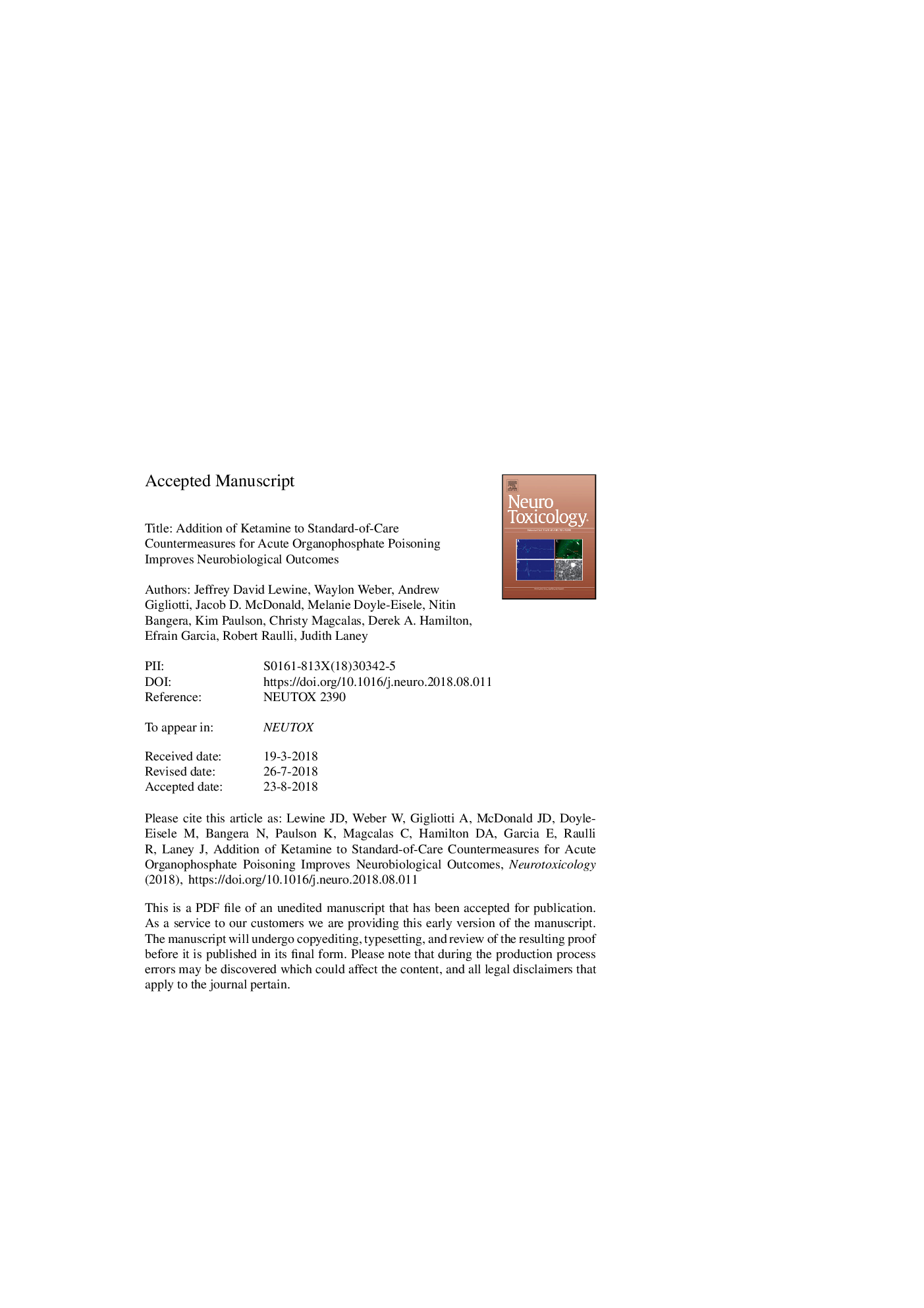| کد مقاله | کد نشریه | سال انتشار | مقاله انگلیسی | نسخه تمام متن |
|---|---|---|---|---|
| 10143398 | 1646165 | 2018 | 34 صفحه PDF | دانلود رایگان |
عنوان انگلیسی مقاله ISI
Addition of ketamine to standard-of-care countermeasures for acute organophosphate poisoning improves neurobiological outcomes
ترجمه فارسی عنوان
اضافه کردن کتامین به مقادیر استاندارد مراقبت برای مسمومیت با ارگانوفسفات حاد باعث بهبود نتایج نوروبیولوژی می شود
دانلود مقاله + سفارش ترجمه
دانلود مقاله ISI انگلیسی
رایگان برای ایرانیان
کلمات کلیدی
موضوعات مرتبط
علوم زیستی و بیوفناوری
علوم محیط زیست
بهداشت، سم شناسی و جهش زایی
چکیده انگلیسی
Rats poisoned with sarin enter into ahyper-cholinergic crisis characterized by excessive salivation, respiratory distress, tremors, seizures, and death. Through the use of rescue medications and an anticonvulsant, death can be avoided in many animals, with the long-term consequences of poisoning partly ameliorated, especially when countermeasures are made available immediately after exposure. However, when anticonvulsant measures are delayed by as little as 30âmin, clinical, neurological, cognitive, and psychiatric abnormalities may persist long after the initial exposure. This study sought to determine if the addition of the NMDA receptor antagonist Ketamine to human standard-of-care countermeasures consisting of two rescue medications (2-PAM and atropine) and an anti-convulsant (Midazolam), would afford protection against persistent neurobiological compromise. Rats were exposed to sarin (105âμg/kg via subcutaneous injection), and treated 1âmin later with 2-PAM and Atropine Methyl Nitrate (IM) to minimize mortality. One of four anti-convulsant protocols was then initiated at 50âmin postsarin:Midazolam alone (MDZ, a single injection (IM) at 0.66âmg/kg); Ketamine alone (KET, a series of five injections (IM) of Ketamine at 7.5âmg/kg, 90âmin apart); Midazolamâ+âlow dose Ketamine (MDZâ+âlowKET, a single injection of Midazolam (IM) at 0.66âmg/kg, plus five sequential doses of ketamine (IM) at 2.5âmg/kg, starting at the time of Midazolam dosing and then 90âmin apart); Midazolamâ+âhigh dose Ketamine (MDZâ+âhighKET, a single injection of Midazolam (IM) at 0.66âmg/kg, plus five sequential injections of 7.5âmg/kg Ketamine (IM), starting at the time of Midazolam dosing and then 90âmin apart). Animals were preassigned to groups culled at post-exposure Days 1, 7 or 30, for histopathology. For all surviving animals, EEG activity was monitored through skull electrodes for 24-h beginning immediately after sarin exposure. Surviving animals also underwent 24-h EEG monitoring on Days 6, 13, and/or 29, post-sarin. Memory assessment using the Morris Water Maze was performed on Days 1, 4, 7, 14 and 30. Following sarin exposure, 85% of surviving animals demonstrated status epilepticus within 20âmin. Each of the anti-convulsant protocols was sufficient to stop convulsions within 1âh of anti-convulsant administration, but all of the animals still showed signs of electrographic status for an additional 2-12âh, without substantial differentiation between treatment groups. However, for post-sarin hours 13-24, the MDZâ+âhighKET group showed significantly less severe EEG abnormalities than the MDZ and KET groups (Mood's Median Test, pâ<â0.005). At one month post-exposure, 90% of animals that had received Midazolam alone still showed evidence of some epileptiform activity. In contrast, 90% of animals that had received Midazolamâ+âhigh dose Ketamine combination therapy had EEG profiles that were within normal limits. This difference in EEG outcomes was highly significant (Mood's Median Test, pâ<â0.001). Likewise, on the water maze, the majority of animals that had received Midazolam combined with either high or low dose Ketamine therapy returned to near baseline levels of mnemonic performance within 2 weeks, whereas the majority of the animals that had received midazolam alone or ketamine alone demonstrated persistent and significant memory impairments even at one month postexposure (Mood's Median Test, pâ<â0.005). With respect to neuronal necrosis, animals in the MDZâ+âhighKET group showed significantly less overall damage than animals in other treatment groups (Mood's Median Test, pâ<â0.001). Of special note were findings in the hippocampus, where only 12% of animals in the MDZâ+âhighKET group showed evidence of necrosis on H&E staining, whereas 100% of animals in the KET group, 70% of animals in the MDZ group, and 40% of animals in the MDZâ+âlowKET group showed evidence of hippocampal necrosis. Overall, the data demonstrate that Ketamine augmentation of an atropine, 2PAM, and Midazolam standard-ofcare for sarin exposure provides clinically-relevant additional protection against the negative neurobiological consequences of sarin, even when initiation of the anti-convulsant countermeasures is delayed by 50âmin.
ناشر
Database: Elsevier - ScienceDirect (ساینس دایرکت)
Journal: NeuroToxicology - Volume 69, December 2018, Pages 37-46
Journal: NeuroToxicology - Volume 69, December 2018, Pages 37-46
نویسندگان
Jeffrey David Lewine, Waylon Weber, Andrew Gigliotti, Jacob D. McDonald, Melanie Doyle-Eisele, Nitin Bangera, Kim Paulson, Christy Magcalas, Derek A. Hamilton, Efrain Garcia, Robert Raulli, Judith Laney,
